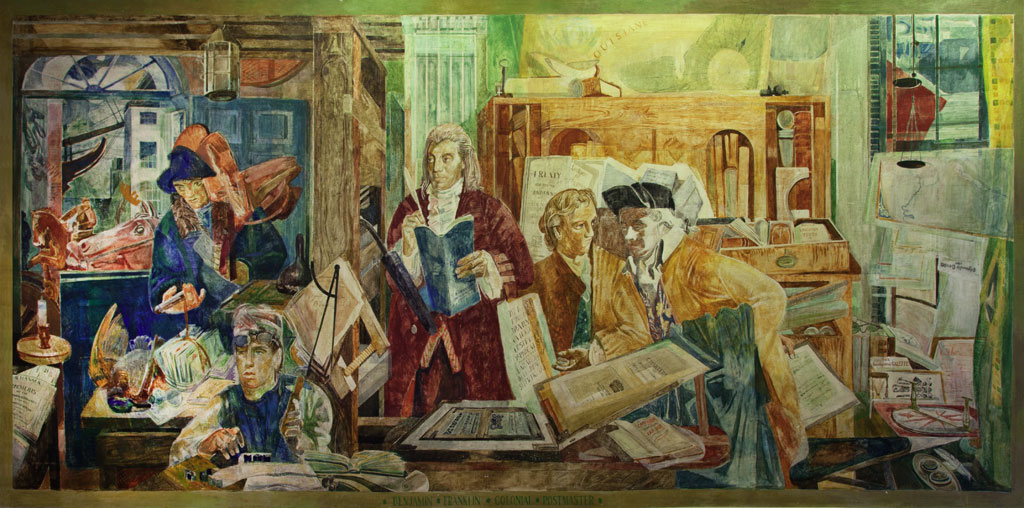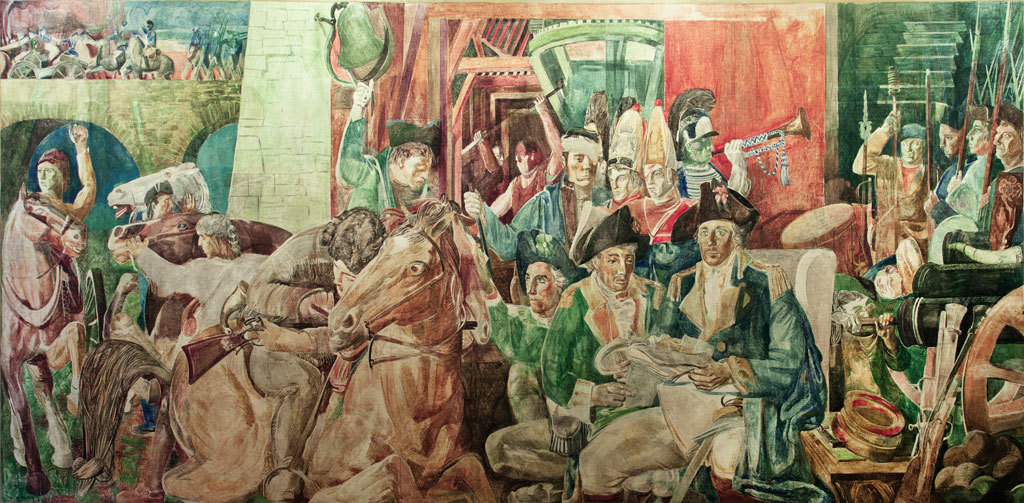George Harding
Ben Franklin, Colonial Postmaster
1938
oil on canvas
71 x 159 in. (180.3 x 403.9 cm)
Commissioned through the Section of Fine Arts, 1934-1943
FA569A
Photo by Carol M. Highsmith

Post Dispatch Rider, 1776
1938
oil on canvas
71 x 159 in. (180.3 x 403.9 cm)
Commissioned through the Section of Fine Arts, 1934-1943
FA569B
Photo by Carol M. Highsmith

On July 26, 1775, members of the Second Continental Congress met in Philadelphia and agreed to appoint a Postmaster General for the colonies, based in Philadelphia, and to create a line of posts from Falmouth, Maine, to Savannah, Georgia. With that, the United States Postal Service was born. Its operation, independent from the British Crown, assured the secure transfer of messages and opened lines of American communication that played a vital role in the battle for independence. The origins of the post are thus tied closely to national identity and the Founding Fathers. In his murals, Harding shows historically based scenes of two Founding Fathers, Benjamin Franklin and George Washington, interacting with the post in key ways.
Benjamin Franklin—author, printer, scientist, inventor, signer of the Declaration of Independence—was the first Postmaster General of the United States. In 1737, when the colonial post was still under control of the British Crown, Franklin was appointed Postmaster of Philadelphia. From 1753 to 1774, he served as joint Postmaster of the American colonies with William Hunter. During this time, he reorganized, expanded, and regularized mail delivery, even allowing mail carriers to travel at night to speed delivery. In 1775, when the colonies created their own Post Office Department, Franklin was appointed Postmaster General. In this mural, Harding depicts Franklin receiving the mail at his printing shop in Philadelphia. Surrounded by many of his own publications and the busy activity of the shop, Franklin stands in the center of the composition signing the post receipt book as a carrier on the left sets a packet of mail on the table. While planning the mural, Harding researched Franklin’s life and work to ensure the historical accuracy of his renderings.
During the Revolutionary War (1775–83), American generals relied on dispatch riders to bring important messages to the battlefield, including news from the Continental Congress as well as crucial information on the movement of British troops. The job of the dispatch rider was honorable but dangerous, often requiring travel through enemy territory with sensitive information. The mural on the right features General George Washington receiving a dispatch. This central scene is surrounded by other vignettes of the war. At the upper left, soldiers on horseback and on foot proceed over a bridge. Beneath them, men (including one in a coonskin cap) wrangle horses. Behind Washington stand four soldiers, one injured, one trumpeting, and all wearing various hats and helmets. At the lower right, a man cleans the barrel of a canon. The attire and activities depicted are based on Harding’s reading of George Washington’s writings and military documents from the Revolutionary era.
Pen and Sword: Harding’s Pictures of the Founding Fathers
George Matthews Harding was born, raised, and educated in Philadelphia and developed an early interest in the founding fathers, particularly Benjamin Franklin. Harding’s understanding of Franklin’s life and publishing career was deepened by the research he conducted in preparation for this mural. At the American Philosophical Society, founded by Franklin in Philadelphia, and the Curtis Collection at the University of Pennsylvania, Harding discovered an expansive collection of documents both written and printed by Franklin. Harding incorporated many of these, including Poor Richard’s Almanack and the Pennsylvania Gazette, into his mural composition.
Harding’s interest in George Washington, the nation’s first Commander in Chief and General of the Continental Army, may have been enhanced by the artist’s own experience on the battlefields of World War I. When the war broke out, Harding was one of eight artists sent overseas with the American Expeditionary Forces to document the conflict. In drawings and paintings, Harding illustrated the struggles of soldiers in the heat of battle. His wartime compositions—often crowded with figures and weapons and packed with action—informed the complicated, almost chaotic composition of Post Dispatch Rider, 1776. To supplement his own battlefront experience, Harding conducted extensive research on the Revolutionary War, reading “The Writings of George Washington” and other military documents of the period.
Harding’s murals of Franklin and Washington focus on two men whose strength and ambition were crucial to the foundation of the United States, and he places each of them in the roles that they embraced: Franklin as publisher and Washington as Commander in Chief of the Continental Army. Mining his own personal interest in these men’s lives, Harding produced paintings that stress the crucial roles of both the pen and the sword in the establishment, unification, and protection of the nation.
George Harding (1882-1959)
Born in Philadelphia, George Matthews Harding studied art at the Pennsylvania Academy of Fine Arts while working as an architect. He traveled widely as an illustrator and writer for the Saturday Evening Post and Harper’s Monthly Magazine, and in 1915 joined the fine arts faculty of the University of Pennsylvania. During World War I, Harding served as a combat artist attached to the American Expeditionary Forces in France, and during World War II he accepted a commission as a combat artist with the U.S. Marine Corps. Harding produced murals for post offices in Philadelphia and Wilkes-Barre, Pennsylvania, as well as a courthouse in Norristown, New Jersey.
George Harding is one of eleven artists whose murals are featured in the William Jefferson Clinton Federal Building. Access to the Clinton Building is restricted, however tours are available through the U.S. General Services Administration. For more information on the GSA Fine Arts Collection in Washington, D.C., please contact artinfo@gsa.gov.

 U.S. General Services Administration
U.S. General Services Administration

